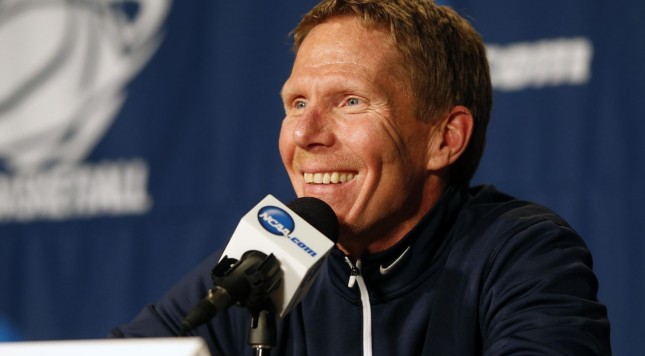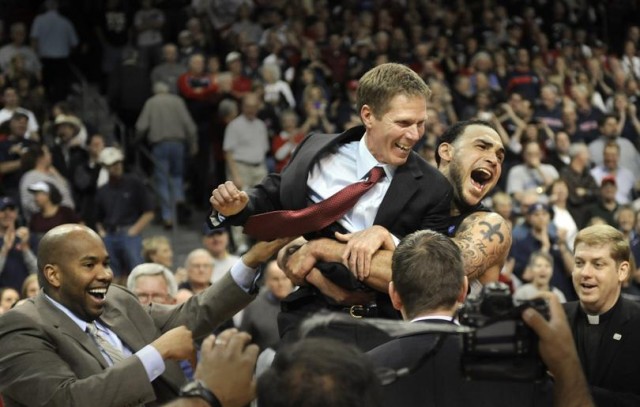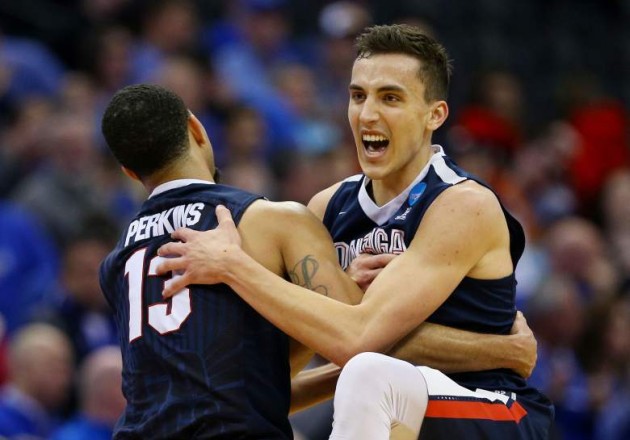Mark Few has always been a good coach at Gonzaga, but at a program which clearly spent a lot to build itself into a national, name-brand operation, good isn’t necessarily good enough.
It’s a statement which not only sounds harsh; it is harsh.
The key question: Is such a statement out of touch with expectations and cultural realities — at Gonzaga in particular, but also at various programs across the country?
Tubby Smith won a national title at Kentucky, but then a second-round exit from the NCAA tournament became the new normal. That wasn’t acceptable at Kentucky, and being completely realistic about the matter, it shouldn’t have been. At Kentucky, it’s not untoward hubris to demand Final Fours with some degree of consistency, and Sweet 16s with machine-cranked regularity. The same goes for North Carolina, which is why “Fire Roy Williams!” becomes a thing, despite two national titles, three Final Fours, and three other Elite Eights in 13 seasons.
Is Gonzaga Kentucky or Carolina? No. Yet, when you build your own new arena, and you capitalize on a run of NCAA tournament success to substantially increase your national profile as a program, the standards of what is and isn’t acceptable begin to change.
Moreover — and more to the point — they ought to.
This is why, entering the 2014-2015 season, it only seemed right to expect more from Mark Few. From 2002 through 2014, Few made the Sweet 16 twice, and one of those Sweet 16 exits was an ugly collapse, one of several memorable NCAA tournament meltdowns examined here by Matt Yoder of Comeback Media.
The 2006 Gonzaga team had Final Four potential, and while Few was nothing less than bitterly unlucky to suffer a collapse — coaches can receive only so much blame for simple lapses by experienced players — the bigger reality overshadowing his career was that Sweet 16 visits stopped happening — only one in the eight seasons following that wrenching 2006 moment against UCLA in Oakland.
When Dean Smith went nine years without a Final Four at North Carolina, he still made the Sweet 16 every year. Roy Williams hasn’t made the Final Four since 2009 at UNC, but he’s made the Sweet 16 or better in three of the six seasons the Tar Heels have fallen short of their ultimate goal. He’s back in the Sweet 16 in this seventh season since 2009, which means that even if Roy fails to reach his ceiling, his floor remains high.
At the start of his Gonzaga career, Few was the inheritor of the Elite Eight team Dan Monson left behind when he took the Minnesota job. Ironically enough, Few became a prisoner of his own success in the course of time, but at the start, he rightly basked in the glow of Gonzaga’s identity as a Cinderella par excellence.
In each of his first two seasons in Spokane, Few made the Sweet 16 as a double-digit seed. This is what Monson did in 1999, enabling Gonzaga to cement its reputation as the little darling of March. Few was the coach who knew how to guide and ride his teams in college basketball’s most consequential month, and because expectations had not been built to a supreme height (in accordance with facilities and resources consumed by the program), Few was able to rest in the knowledge that he was maxing out, relative to his situation.
Then, however, the paradigm changed.
This guy came to the Gonzaga program, and GU became a top-3 seed in the NCAA tournament for three straight seasons:

Adam Morrison, the man who changed expectations and thresholds at Gonzaga, despite failing to make a Final Four or an Elite Eight.
*
Over a decade with Gonzaga, Few’s ceiling was not supposed to be as high as it is at Power 5 programs… but it was rarely reached. A steady stream of mid-level seeds (mostly in the 6-10 range) led to a parade of first-weekend exits.
When the program attained its first-ever No. 1 seed in 2013, thanks to Kelly Olynyk, it seemed GU was about to arrive at a long-sought transformational moment which matched the school’s ambitions on the basketball court. When Wichita State — a mid-major, but also a well-funded one — stole the Zags’ thunder in a jarring round-of-32 upset powered by Ron Baker, the effect in the short term was shattering. Few had traveled from one side of the mountain to the other, and he hated the view.
In 2000 and 2001, Few was the architect of upsets over much higher seeds en route to the Sweet 16. In 2013, he was the top seed bumped off by another mid-major coach. The 2014 season — sans Olynyk — was never going to replicate 2013’s achievements, so as the 2014-2015 season (and then NCAA tournament) began, Few faced a fresh challenge with a loaded roster.
Finally, as a 2 seed, Gonzaga cracked the Elite Eight for the first time in Few’s tenure. His collection of upperclassmen and transfers from other programs — Few was very deft in using to transfer market to his advantage — played three very steady games and gave top-seeded Duke a good fight in the South Regional final. The elusive Final Four remained just out of reach, but March finally ended with a rich sense of achievement — somewhat akin to 2009, but especially reminiscent of 2001, when it was impossible to be worried about the future of Gonzaga basketball.
Yes, Kevin Pangos and Byron Wesley and Gary Bell met the end of the line, and yes, this subsequent season witnessed an injury to big man Przemek Karnowski, but after making that Elite Eight, Gonzaga didn’t have to enter March asking itself as many questions this time. Sure, the Zags struggled this season, in large part because Eric McClellan — another transfer picked up by Few — didn’t meet his potential. Yet, the Zags were always able to tell themselves, even as they skirted the NCAA tournament bubble, that as long as they found a path into the Big Dance, these limitations could be addressed.
The performance of McClellan against Utah — lighting up the Utes for 22 points on 9-of-12 shooting — continued what he started in the WCC Tournament. McClellan averaged 20.3 points in three games. The light went on at the right time for a Gonzaga team which snuck into the field with a double-digit seed.
Wait a minute — this all sounds familiar.
Yes, it is not an idle coincidence — maybe not the way Few expected to come full-circle at Gonzaga, but a path which certainly enabled this season’s returning players to believe they could recapture the March mojo they displayed a year ago.
These are random results in the NCAA tournament’s one-and-done environment. 2 plus 2 equals 4 is a mathematical certainty on par with “one team’s gotta win and one team’s gotta lose.”
Players gaining belief from a previous instance of tournament success is not something which math can lock down. Yet, it is an internal truth of competition and the human psyche — not universal, not equally applicable to all teams in all circumstances, but very much one part of the alchemy of growth and development in the theater of big-time sports.
Gonzaga didn’t do much growing as a program from 2007 through 2014. Mark Few’s program and career had definitely stagnated.
Now? Few has come full circle with GU. He’s working magic and re-creating the legitimate sense that the Zags are zigging in the right direction once again.
We’re a long way from 2001… and yet it feels like that year again for Gonzaga.
Hope, an optimistic tone, a recovered sense of fulfillment — they’re all back in Spokane.
It’s about time.



